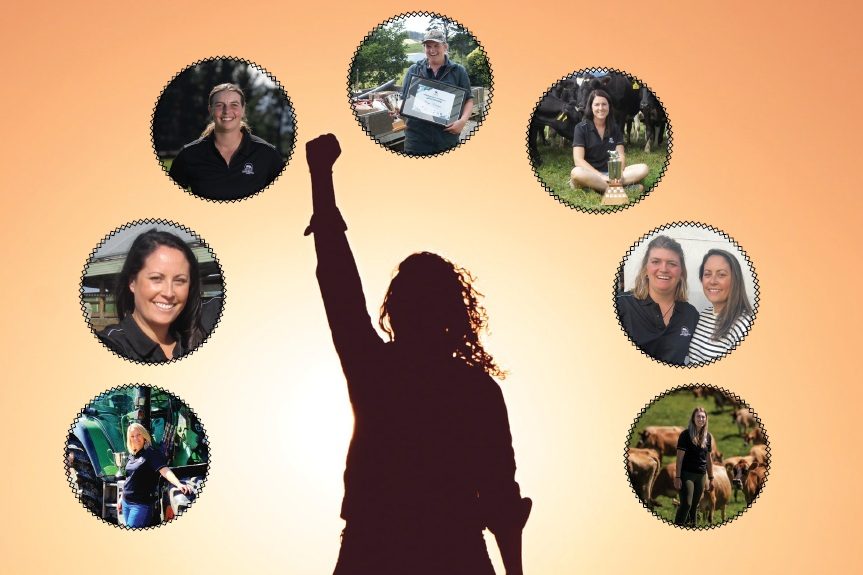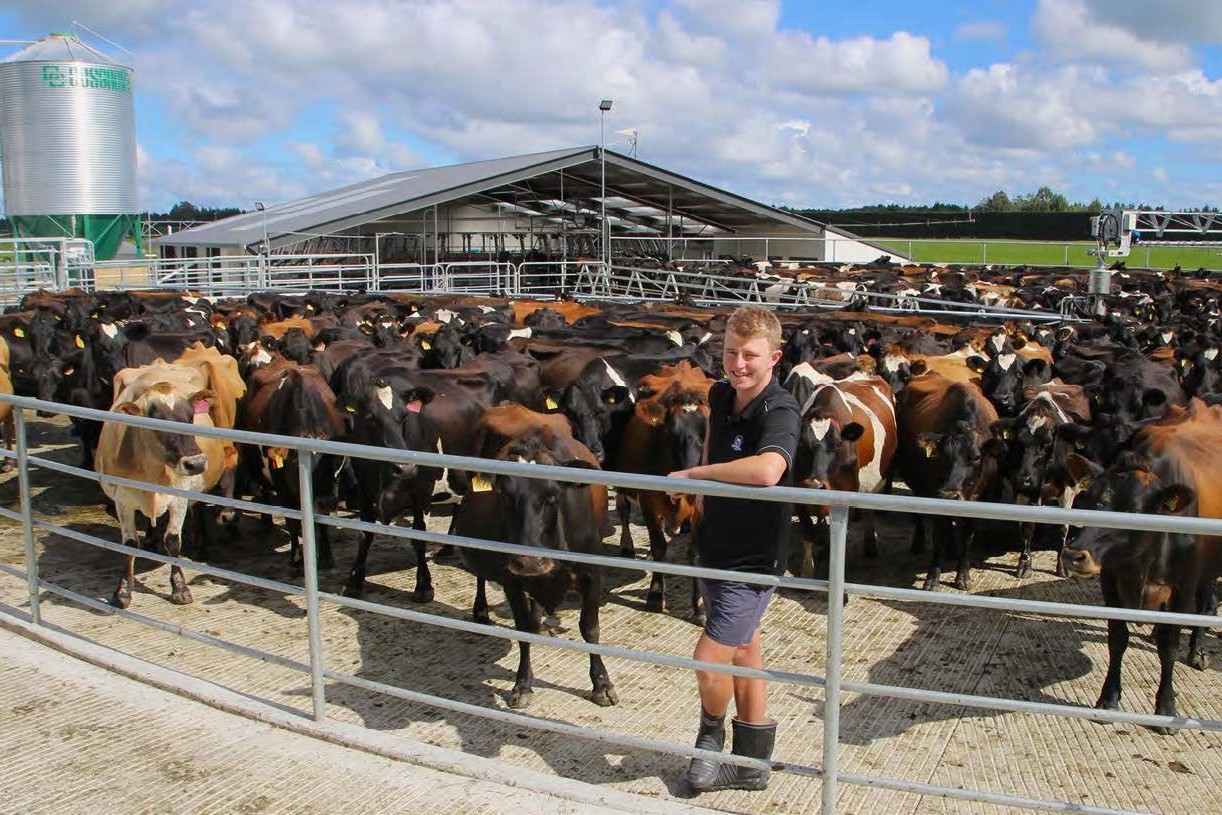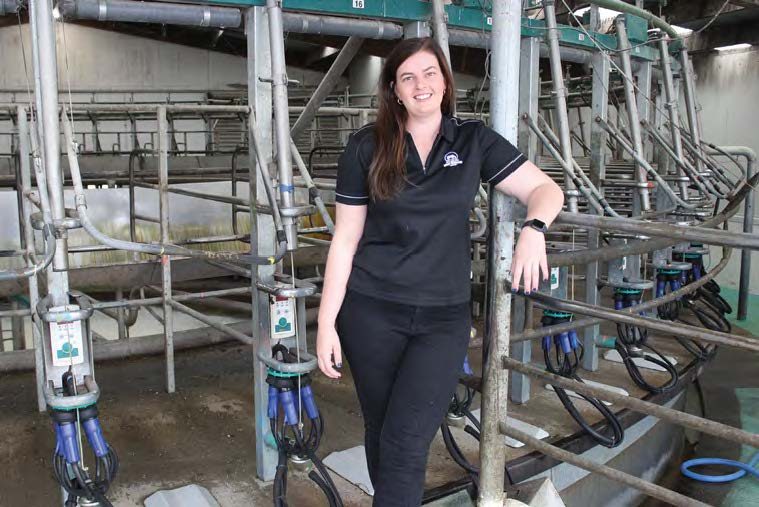Jackie Harrigan
Sharemilking for three years in the Waimarino region on a high-altitude low-input farm has been a great time for Thomas and Jemima Bebbington both for their business growth and family life.
The Ohakune dairy farmers won the Sharemilker of the year award in the Manawatu Dairy Industry Awards and are next season shifting back to the Waikato to sharemilk 600 cows on the Te Aroha family farm belonging to Tom’s mum, to help out since his dad passed away last year.
It’s not without regrets that they are leaving the small but very friendly community of Ohakune.
Tom, a career dairy farmer, grew up in the Galatea and Waikite Valley area of the Bay of Plenty but Jemima had lived for a few years in Ohakune with her stock agent father when she was a child so was familiar with the region. The stock agent connection certainly opened doors.
The picturesque 160-hectare effective dairy platform belongs to Andrew Wightman and along with 15ha of young stock support land, the property has a further 45ha of QEII-covenanted bush (4ha) and fenced off riparian margins along a river that runs into the Mangawhero River – one of the best trout fishing streams in the country, Tom says.
And of course the beauty of the Ohakune basin and bush-clad foothills is totally dwarfed by the sheer magnitude and presence of Mount Ruapehu – a constant reminder in the long, cold winters.
Tom and Jemima have increased milk production from the 425 peak-milked cows year-on-year at the property, where they have a 150,000kg milksolids (MS) quota put in place by the owner.
They stepped up from a 250-cow sharemilking job in Piako when they needed a new challenge and Tom saw the job advertised online and he suggested jokingly to Jemima that they took a look.
“And we were offered the job and took it – and have loved it.
“It was lots of little things – that fantastic mountain view, the self-contained nature of the job, the beautiful infrastructure and large shed and the appealing job.
“The climate is certainly harder but we were up for a challenge – I love the chance to optimise potential in a property, it’s been an amazing opportunity.”
Milk production hovered around 120,000kg MS when they arrived and the couple soon ramped it up to 150,000kg, where the farm owner had set targets.
Pasture is Tom’s forte – borne out by his winning of the Ravensdown Pasture Performance Award at the awards night and he is super diligent about recording everything that happens.
“Dad was really strict on keeping records on everything so that’s how I learned.
“I always have two notebooks on me, one for last season and one for the current season where I record pasture walks and residual levels so I can compare year-on-year and can see trends.”
He also uses the three-leaf system as a guide, although he says the pasture in the Ohakune region has a short growing season and always tries to go to seed very quickly so he has to speed up the rotation, use lots of topping and shut up paddocks for silage.
“Dad always said the difference between a good farmer and an average farmer is about three days and I reckon we have about 1.5 days here to make a decision over the peak growing season.
“The grass growth takes off really quickly, I have tried a 12-day rotation with up to four shifts each day – but then we can have a four-degree day and growth slows.
“The growth is awesome, we are just running through the flush.”
The area is like an undiscovered gem, Jemima says, with amazing land and beautiful fertile soils but the downside of 600-metres above sea level is long cold winters with zero or very little grass growth through May, June, July and August.
Tom and Jemima make as much silage as they can, aiming for 50ha of the milking platform and they also buy in 100 bales of hay for the low-input System 2 farm.
Most seasons they have also bought in 120 tonnes of palm kernel to fill a feed deficit over calving with an extra 30t this summer to cover the drier January/February months.
“The last two seasons we had lovely wet summers,” Jemima says.
A pivot and a half are installed to irrigate 85ha but Tom has only just fired it up for three weeks – the first time in three years it has been used.
The long winters can have up to 30 days of frost but Tom says it’s just a mindset – “you know it’s going to be really cold outside but you just layer up for it” and Jemima says she prefers the crisp dry cold Ohakune days to Waikato’s wet cold.
Having a well-insulated house and a great woodburner has kept them toasty and warm – Tom says he can spend days inside in his stubbie shorts and singlet. And the best thing is the long winter break – the cows go on to once-a-day (usually in late January) once he can see them hitting their 150,000kg MS target by dryoff in late April. Calving in mid-August
gives a “solid 3.5 months off milking” which is great for both the cows, staff and the Bebbington family.
“Being dry for that long it’s easy to put condition on the cows and they are really healthy.”
The low-cost system has proven to be very profitable for the Bebbingtons, who have managed to constrain farm working expenses at $1.50/kg MS.
“It’s a very resilient and payout-safe system here – we have really got no
reason to leave – except to grow bigger and to help out Tom’s family situation.”
Their worker Shannon is relocating to the Waikato with them – “even though we have told him it will be a lot harder there – no long winter break or autumn OAD milking”.
The couple also won the Meridian Energy Farm Environment Award and the Westpac Personal Planning and Financial management award for their financial skills. When they moved to Ohakune they bought 130 cows from their first 50:50 job, purchased Andrew’s cows and were able
to bridge the finances by selling one of their rental properties.
Planning the shift back to the Waikato has meant changing from the late calving date back to an earlier date, which wasn’t easy.
Having used CIDRS in the past Jemima and Tom were not keen to go down that road so they put the bulls out a month early and then pulled them out at the end of October as soon as the AI technician was available. Four weeks of AI was followed up with the bulls out again.
“We were budgeting on 20-30 extra empties and while the empty rate was up to 18% we might only need an extra 50 cows.”
The couple proactively sent off some empty cows early, rather than cull them, to Tom’s mum’s autumn calving property where they will be milked through the winter.
“We have been looking at scenarios to make it work for everyone and have bought some high index empties and plan to buy another 60 in-calf off my brother for our new job.”
‘It’s nice to be able to keep our own cows from a biosecurity perspective.”
They have invested in a 27ha runoff at the end of their new farm as a support block to keep their young stock close and carry on the self-contained theme.
Tom is a firm believer in A2 milk and wants to pursue a full A2A2 herd when they relocate.
They have also grown the Guernsey component of their herd, among their Kiwi cross cows. When the first herd they bought had a number of Guernsey cows they appreciated the finer-bone characteristics. heat tolerance and mild temperament of the cows.
They have since joined the NZ association, registered their cows and
Tom is now vice president of the breed group. Jemima jumped in to help organise the 2016 World Guernsey breeders conference and a two-week tour of the country.
The pair enjoyed meeting breeders from all over the world and are keen to travel and see some of the cows in other countries – especially the island of Guernsey. In their own herd they are keen to build up Guernsey numbers by retaining as many heifers as they can and will sell off or
pass on Guernsey bull calves to promote the breed.
Jemima also works part-time for her family’s manufacturing and wholesaling cosmetics company from a distance and runs the couple’s accounts while looking after three children Violet, 8 Jack, 6 and Lottie 2.
Tom is involved in the children’s motocross riding exploits where Violet
is the “happiest rider on the track and potters along at the back of the pack and Jack is hard out trying to win”. He also helps with primary school motocross meets.
Tom and Jemima have entered the share milker section the Dairy Industry Awards before but felt this year would be good timing to force themselves to do scenarios and budgets for their move to the Waikato.
“The entry has worked as professional development, now we know we can buy our own farm in five years’ time.
“It made us look at all the gaps in our business – and it’s been like free
PD – we have had lots of feedback from industry professionals for free – it’s been invaluable.”
SHARE FARMER MERIT AWARDS:
DairyNZ Human Resources Award, Honda Farm Safety and Health Award – Alyssa and David Rae
Ecolab Farm Dairy Hygiene Award – Lachlan and Rhianne Fee
Federated Farmers Leadership Award, LIC Recording and Productivity Award – Renae Flett
Meridian Energy Farm Environment Award , Ravensdown Pasture Performance Award, Westpac Business Performance Award – Jemima and Thomas Bebbington





